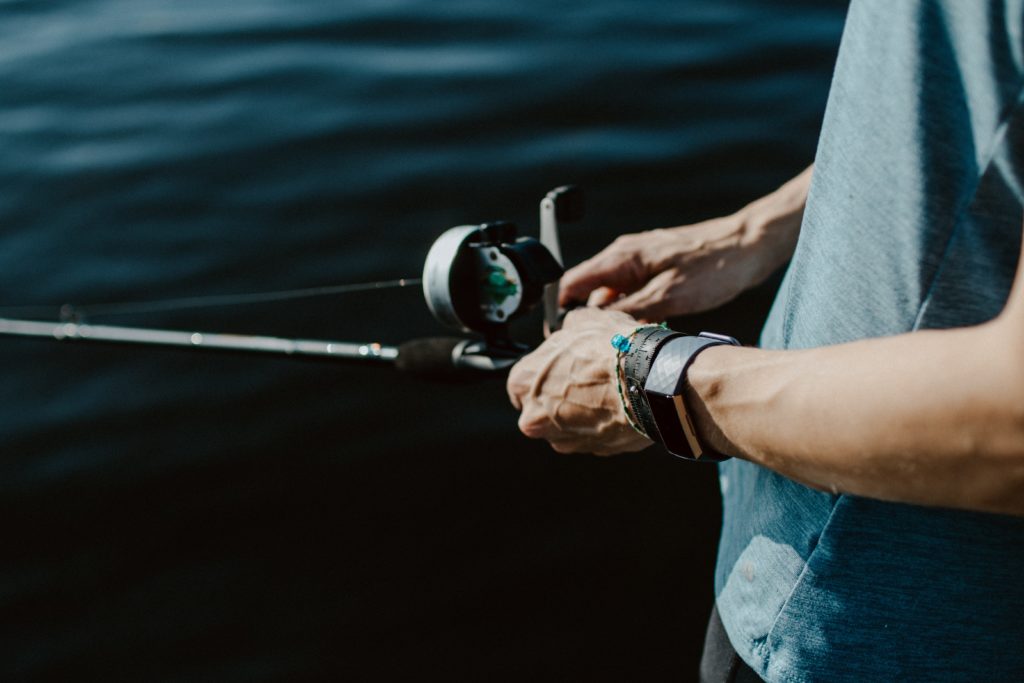So you’ve got your rod, your reel, your bait, and your tackle. All you need now for your fishing trip is the line. But what type of line should you buy? And what weight should you choose? Let this be your comprehensive guide to answering these questions.
First Things First: How Line Strength is Measured
The strength of the fishing line is measured in a “pound test” (or lb test). This unit refers to the amount of weight that can be applied to the line. For example, an 8 lb test line could be used to lift an eight-pound cinder block, while a nine-pound block would cause it to snap.
Keep in mind that when fishing, the drag system on your reel means that the full weight of a fish will never pull on your line. This means you don’t need a 50 lb test line to catch a fifty pound fish. With your drag properly set so that the fish can “take some line” during a fight, you can catch fish that weigh much more than the pound test of your line.
Type of Line: Braid versus Monofilament
The first decision you need to make is what type of line to use. The most common types of line are braid and monofilament. Monofilament, often called “mono,” is the standard line that anglers have been using for generations. Braided line is thinner, sharper, and lighter. Beginners are better off using a monofilament line because it doesn’t tangle as easily and allows you to tie a number of standard knots. Braided line allows you to cast farther and put more line on a smaller spool, but it tangles easily and requires special knots.

General Rules for Braid
If you opt for a braided line, then you should know that your decision changes everything about the choice of lb test. Because it is so much thinner and lighter than monofilament, anglers typically use a much higher lb test. For freshwater, you should go with a 10 or 15 lb test. For saltwater, 30 or 50 lb test is standard.
General Rules for Monofilament
With monofilament line, anglers use lighter lb tests because they need to maintain the ability to cast properly and keep a suitable amount of line on their spools. In freshwater, a 4-12 lb test is standard. For small trout and sunfish, a 4 lb test is okay. For bass or general freshwater fishing, 6-8 lb test is the norm. In saltwater, 12-15 il test is standard when using light tackle for smaller species, while 17-20 lb test allows you to target bigger fish.
Other Things to Consider
The line weights mentioned above are only general guidelines. You should make your ultimate decision only after considering all the factors of your particular fishing strategy.
Casting Distance Important?
If you’re fishing from a boat or in a place where casting distance doesn’t matter, then you can play it safe and go with a heavier line. In a situation where every yard counts (surfcasting, for example), then you should choose a lighter line (or even braid).
Lures or Bait?
When bait fishing, you toss your rig out and let it sit. Since you’re not casting as often, a heavier line is okay. Fishing with artificial lures requires more finesse, and you might want a lighter line for better casting.
Size of Your Spool?
If you’ve got a small reel, then you should opt for a lighter line. You can’t put a heavy line on a small spool because not enough of it will fit. That’s why it’s so important to buy the proper sized reel in the first place.
Personal Challenge or Catch at all Costs?
If your goal is simply to catch some fish, then a heavier line is often the way to go. Some anglers, however, enjoy the personal challenge of landing fish with lighter lines. Some even opt for a 2 lb test while trout fishing because it requires them to set the drag properly and fight with patience. If you’re a beginner, it’s probably best to keep it simple and avoid this approach.
Recap
A lot of strategizing goes into choosing the lb test of your fishing line. Ultimately, it’s up to you to use the information available and make the right decision.
This article was submitted by a guest writer from All Rivers & Saltwater Charters. They have been in service for over a decade but still consider themselves the “new school” type of Seattle Fishing Charter specializing in hands-on techniques, and the latest in boats, and equipment! Led by full-time, professional guide and captain, Mark Coleman, the All Rivers & Saltwater Charters team offers shared and private, fully furnished Washington fishing charters for Salmon, Steelhead, Tuna, Lingcod, Halibut, and Crab. Their charter fishing locations include the Seattle area rivers, Puget Sound, Westport, Anacortes & San Juan Islands, the Columbia river and Olympic Peninsula rivers. Freshwater or Saltwater, where your trip takes place depends on where fishing is best at that time of year.






![Air gun 101: The differences between .177 & .22 – Which jobs they do best ? [Infographic]](https://airgunmaniac.com/wp-content/uploads/2020/09/g44-218x150.jpg)








































![Air gun 101: The differences between .177 & .22 – Which jobs they do best ? [Infographic]](https://airgunmaniac.com/wp-content/uploads/2020/09/g44-150x150.jpg)